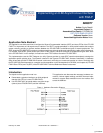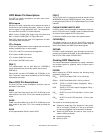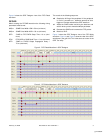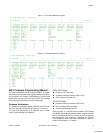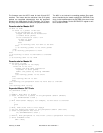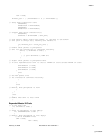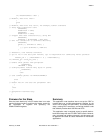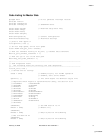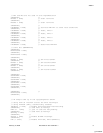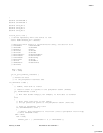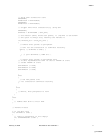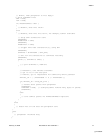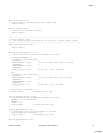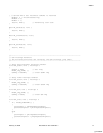February 19, 2008 Document No. 001-15342 Rev. ** 7
AN6077
if( EP68FIFOFLGS & 0x01 )
{
// EP6FF=1, when fifo "full"
}
else
{
// EP6FF=0, when fifo "not full", for example, buffer available
// setup GPIF transaction count
SYNCDELAY;
EP6GPIFTCH = 0x02;
SYNCDELAY;
EP6GPIFTCL = 0x00;
// trigger FIFO read transaction(s), using SFR
SYNCDELAY;
GPIFTRIG = GPIFTRIGRD | GPIF_EP6;
// wait for transaction to terminate naturally
SYNCDELAY;
while( !( GPIFTRIG & 0x80 ) )
{
; // poll GPIFTRIG.7, DONE bit
}
// AUTOOUT=1, core handles transfers
// cpu is not in the data path however, cpu is responsible for committing "short packets"
xFIFOTC_IN = ( ( EP6FIFOBCH << 8 ) + EP6FIFOBCL );
if( xFIFOTC_IN < enum_pkt_size )
{
// handle short packet from peripheral
SYNCDELAY;
INPKTEND = 0x06;
// w/skip=0;commit however many bytes in packet.
SYNCDELAY;
}
else
{
// core commits packet via EPxAUTOINLENH/L
}
else
{
// master has all the data the peripheral sent
}
}
else
{
// peripheral interface busy
}
}
Firmware for the Slave
Since the slave works only in AUTO mode, there is no code
required for data transfer to and from the master, except for
the initialization of registers and specifying the
EP6AUTOINLEN registers.
Summary
This application note describes how to set up the GPIF to
transfer data over an 8-bit asynchronous interface (to the
slave FIFO of another EZ-USB FX2LP). It includes hardware
setup, creating GPIF waveforms, and writing the 8051 code
that arbitrarily handles both USB INs and OUTs.
This application note is centered around a specific back-to-
back board setup with two EZ-USB FX2LP boards. However,
many concepts and insights conveyed in this document can
be applied to and used as a basic framework for mainstream
applications.
[+] Feedback



